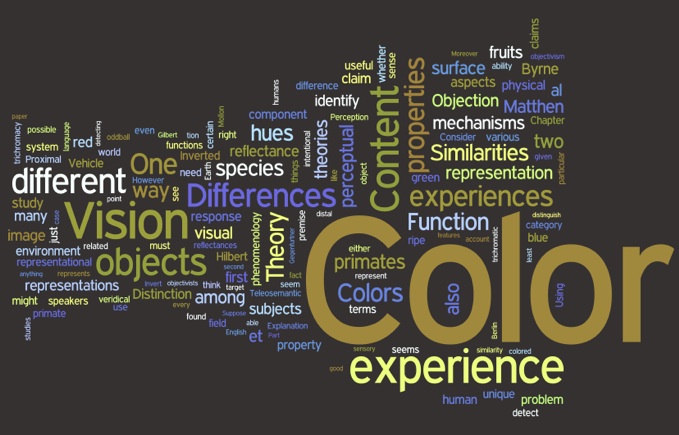Here's another way of summarizing my dissertation:

Here are a few of my areas of active research. A few of them derive from work started in my dissertation and some are projects from various other interests.
Philosophy of Perception
Teleosemantic theories aim to understand intentional phenomena, e.g. representations, in terms of the (biological) purpose or function of the mechanisms that produce and use them. Color vision, the subject of my dissertation, is a comparatively well-understood perceptual system, so it provides a good test case for the teleosemantic program. Looking at recent studies in psychology, anthropology, and evolutionary biology, I argue for a teleosemantic theory of color. Moreover, I argue that this teleosemantic approach to color perception makes better sense of some of the puzzling aspects of color, including metamerism and misperception, than rival theories. My future research will continue to develop and test the teleosemantic program in different domains of perception. I'm also interested in the psychological research on attention and perceptual saliency.
Philosophy of Language
I am interested in the nature of and appeal to semantic intuitions in empirical linguistics. In particular, is it good linguistic practice to appeal to native speakers' intuitions about semantics in the same way that linguists have been appealing to intuitions about syntactic phenomena? I argue for a limited use of such intuitions and also argue that these semantic intuitions are fundamentally different from those discussed by several philosophical theories of intuitions. I have also done work on context-dependence and the semantics of conditionals.
Philosophy of Mind
Metaphysics
Debates in philosophy of mind over supervenience and overdetermination have recently spilled into the metaphysics of ordinary objects. I claim that just as psychology and biology are relevant to questions of nature of color properties, so those fields can be relevant to the nature of objects. Quine was right that entification begins at arm's length and are things glimpsed not glimpses, but examining how object perception works tells us something about what we're looking at.
My dissertation is a teleosemantic approach to color. Teleosemantic theories aim to understand intentional phenomena, e.g. representations, in terms of the (biological) purpose or function of the mechanisms that produce and use them. Color vision is a comparatively well-understood perceptual system, so it provides a good test case for the teleosemantic program. Looking at recent studies in psychology, anthropology, and evolutionary biology, I argue for a teleosemantic theory of color. Moreover, I argue that this teleosemantic approach to color perception makes better sense of some of the puzzling aspects of color, including metamerism and misperception, than rival theories. One particularly vexing aspect of color, the similarities and differences among colors, gets special attention. A red ripe tomato and an orange pumpkin resemble each other insofar as they both appear reddish and differ insofar as the pumpkin is also appears quite yellowish, while the tomato does not appear as yellowish. The Similarities and Differences objection is that color objectivism cannot identify any properties of purportedly colored objects that bear the same relations of similarity and difference as color experiences do to each other. I develop a response to this objection that appeals to the distinction between the content and vehicle of a representation. The relations of similarity and difference are non-representational aspects of the vehicles of color experiences. Recognizing a role for vehicular properties promises similar applications to recent work done on color categorization and other sensory qualities. Finally, I discuss the relation between color perception and the semantics of color terms. In particular, I argue that the perceptual color categories constrain the application of color terms and that color terms are thereby more context-sensitive than others have thought.
Here's another way of summarizing my dissertation:
